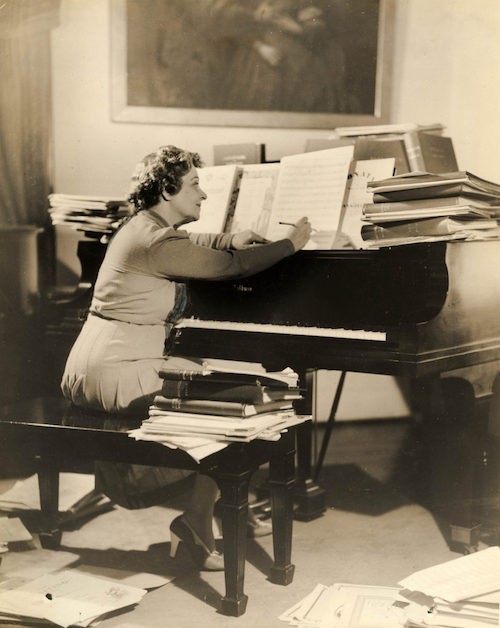Orchestra Miami salutes the pioneering Miami composer Mana-Zucca in style
Orchestra Miami presented a portrait concert of Mana-Zucca Sunday afternoon, at the Miami Woman’s Club. Orchestra Miami’s artistic director and pianist Elaine Rinaldi was joined by violinist Karen Lord Powell, cellist Aaron Merritt, and baritone Philip Kalmanovitch as part of the series “Discover Miami Through Music.”
If the name Mana-Zucca sounds unfamiliar, you are not alone. This fascinating composer, pianist, and singer is now largely unknown to the classical music scene. Born Gussie Zuckermann, in 1885 in New York City, she adopted the stage name Mana-Zucca (a fun rearrangement of her last name) after having already started performing as a child prodigy.
After touring Europe and living for a time in Berlin and London, Mana-Zucca returned to the U.S., married businessman Irwin M. Cassel, who enthusiastically supported her musical career, and in 1925 they made Miami their permanent home. Besides composing and presenting musicales in her home, “Mazica Hall,” she also taught various aspiring pianists, among which is another revered Miami figure, pianist and educator Ruth W. Greenfield. (Greenfield was the first educator to create an arts conservatory in the 1950s where students of all races and heritages were accepted.) She died, age 95, in 1981.
Each half of the program was bookended by some of Mana-Zucca’s vocal works. A sweet Americana vibe emanated from “Wot’s so great about Spinach” from Spinach and ‘Leven Other Songs, “Nichavo!” (Nothing Matters!) closed the first half with a slightly dark sense of humor, resembling settings of Kurt Weill.
The second half showed a wider range of vocal content, from a chirpy and humorous “My Dad’s a Swell Guy” to a sudden shift in mood with “Rachem” (Mercy) and ending the concert with Mana-Zucca’s most recorded song, the exultant “I Love Life.” Kalmanovitch sang with clear diction, beautifully sustained phrases, and seamless transitions through his vocal compass. He is a well-rounded performer who conveyed the emotional essence of each song with convincing musicality.
The program also featured character pieces for violin and piano. The semi-impressionistic Fisherman’s Wharf leaned on searching and mysterious sonorities, the piano evoking the fluency of water and the violin singing with quiet intensity. Hakinoh and Toccata from Handel’s Organ Concerto were polar opposites of one another, the former filled with rhapsodic nuances and the latter with playful articulations in a Baroque style. Lord Powell and Rinaldi collaborated in showcasing Mana-Zucca’s affinity for harmonic exploration.
Two duos for cello and piano, written 32 years apart, gave a further insight into Mana-Zucca’s creative range. Ballade et Caprice (1923) opened with pleasant flourishes and improvisatory figurations. It soon leaped into an energetic outburst of rapid staccato passages and demanding double-stops. Merritt and Rinaldi managed to capture the upbeat spirit of this capricious musical essay.
The Sonata for Cello and Piano (1955) was one of the most substantial works on the program. The four movements, packed with interesting rhythmic motives, unexpected harmonic turns, and overlaid textures, also display Mana-Zucca’s influences— Gershwin and Poulenc, among others.
The first movement was executed with eloquent phrasing, good contrast of characterization in rhythmic versus lyrical moments. The second movement offered a gentle respite with a more transparent tone.
While the scherzo’s perpetual motion was delivered in a somewhat heavy manner with repeated cello intonation issues, yet the duo delivered the impassioned writing of the fourth movement with compelling tone production and thoughtful playing. This sonata, dedicated to Jean Bedetti, is certainly deserving of more performances and listeners, and it was considered by Mana-Zucca to be her most accomplished work.
In the same vein as the cello sonata, the Trio for Violin, Cello, and Piano written in 1921 displayed Mana-Zucca’s breadth of musical expression. Structured in three movements, the work begins with an interrupyed conversation between the piano and the strings who then intertwine in flowing piano passages and blossoming melodies in the strings. The second movement, a processional funeral march, was played with rich tone and balanced phrases. The finale served up jaunty offbeat rhythms, repeated-note passages exchanged between the instruments, and an overall galloping energy.
With this trio, Mana-Zucca offers amix of nostalgia, wonderment and the bustling flair of the early 20s. Powell, Merritt, and Rinaldi brought a wide variety of dynamics, inflection, and characters from the score. The ensemble blended well together and their committed playing did the music justice.
Orchestra Miami continues its season with a children’s concert “The Three Little Pigs”, an opera-pastiche on the music of Mozart, 3 p.m. January 8, 2023, at Pinecrest Gardens. orchestramiami.org
Posted in Performances
Leave a Comment
Mon Nov 7, 2022
at 1:25 pm
No Comments
